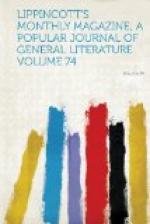This hall witnessed, certainly in the reign of George I., and according to tradition in that of Elizabeth, the mimic reproduction of the great drama with which it is associated. It is even said that Shakespeare took part here in his own play, King Henry VIII., or the Fall of Wolsey. In 1558 the hall was resplendent with one thousand lamps, Philip and Mary holding their Christmas feast. The princess Elizabeth was a guest. The next morning she was compliant or politic enough to hear matins in the queen’s closet.
The Withdrawing Room opens from the hall. It is remarkable for its carved and illuminated ceiling of oak. Over the chimney is a portrait of Wolsey in profile on wood, not the least interesting of a long list of pictures which are a leading attraction of the place. These are assembled, with few exceptions, in the third quadrangle, built in 1690. Into this we next pass. It takes the place of three of the five original courts, said to have been fully equal to the two which remain.
[Illustration: Middle quadrangle, Hampton court.]
The modern or Eastern Quadrangle is a hundred and ten by a hundred and seventeen feet. It is encircled by a colonnade like that in the middle square, and has nothing remarkable, architecturally, about it. In the public rooms that surround us there are, according to the catalogue, over a thousand pictures. Leonardo da Vinci, Paul Veronese, Titian, Giulio Romano, Murillo and a host of lesser names of the Italian and Spanish schools, with still more of the Flemish, are represented. To most visitors, who may see elsewhere finer works by these masters, the chief attraction of the walls is the series of original portraits by Holbein, Vandyck, Lely and Kneller. The two full-lengths of Charles I. by Vandyck, on foot and on horseback, both widely known by engravings, are the gems of this department, as a Vandyck will always be of any group of portraits.
[Illustration: Archway in Hampton court.]
Days may be profitably and delightfully spent in studying this fine collection. The first men and women of England for three centuries handed down to us by the first artists she could command form a spectacle in which Americans can take a sort of home interest. Nearly all date before 1776, and we have a rightful share in them. Each head and each picture is a study. We have art and history together. Familiar as we may be with the events with which the persons represented are associated, it is impossible to gaze upon their lineaments, set in the accessories of their day by the ablest hands guided by eyes that saw below the surface, and not feel that we have new readings of British annals.
[Illustration: Wolsey.]




